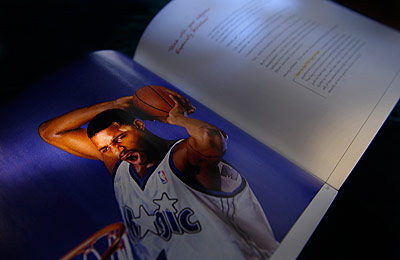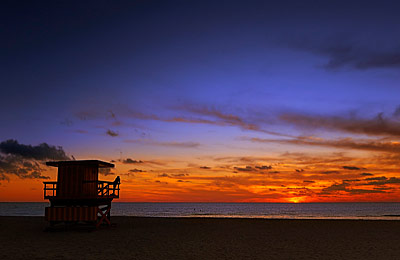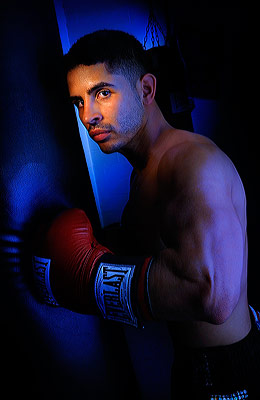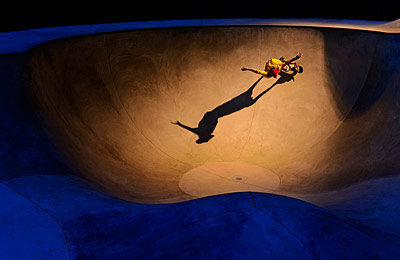|
 Image #1 Book Man … The March 2008 edition of Workshop at the Ranch featured a photographer other than myself, Joe McNally. Joe’s brilliant book The Moment It Clicks is a must read for every photographer. Sometimes taking the time to read a book is a bit more than some can handle, but if you would rather just look at the incredible pictures first and read second … Joe’s book has plenty of images that take your breath away. Many of you might go further and like to read the captions too, especially if it has data regarding how a picture was made … Joe’s book also has lots of info and data. Some folks will even read a paragraph or two, but only if it teaches them something useful and if it is laced with real life experience and humor … Joe’s book definitely has that and much, much more. So whether you want a casual read, or in-depth study The Moment It Clicks is for you. Before every shoot, yes every shoot I reach for The Moment It Clicks and read a page or two. It charges me up. It gets my mind thinking. It motivates and inspires me. Get it, read it, be like Joe! Image #1 Book Man … The March 2008 edition of Workshop at the Ranch featured a photographer other than myself, Joe McNally. Joe’s brilliant book The Moment It Clicks is a must read for every photographer. Sometimes taking the time to read a book is a bit more than some can handle, but if you would rather just look at the incredible pictures first and read second … Joe’s book has plenty of images that take your breath away. Many of you might go further and like to read the captions too, especially if it has data regarding how a picture was made … Joe’s book also has lots of info and data. Some folks will even read a paragraph or two, but only if it teaches them something useful and if it is laced with real life experience and humor … Joe’s book definitely has that and much, much more. So whether you want a casual read, or in-depth study The Moment It Clicks is for you. Before every shoot, yes every shoot I reach for The Moment It Clicks and read a page or two. It charges me up. It gets my mind thinking. It motivates and inspires me. Get it, read it, be like Joe!
|

Image #2 Fall Foliage … When I wrote the May 2008 article about taking a series of images and merging them into one PANORAMIC picture I thought I might be preaching to an already savvy choir, but after receiving a flood of emails praising my in-depth explanation of the technique, I learned that “how to do it well” was still a mystery to many landscape/nature photographers. This article was one of several that I have written over the past few years that teaches something other than sports photography. No doubt it is evident to those who have been reading the Workshop at the Ranch articles over the past 6 years that my business has been evolving. I photograph many more subjects in addition to sports these days and from the emails I have received many of you who come on a regular basis are from a variety of photographic subjects including Landscape , Nature , and Portraiture. I’m thrilled that many of you “Learned Something New” from the May Workshop at the Ranch and I plan on continuing with a variety of teachings and techniques. Nikon COOLPIX P80, ISO200, Aperture Priority, PANORAMA Mode, WB Cloudy, Lexar 2G SD Card.
|
|
 Image #3 South Beach Sunrise … From time to time I like to share some unusual tricks, techniques, and equipment items that I find useful to my photography. The June 2008 edition of Workshop at the Ranch explained seven techniques I used during the week of horseracing at Churchill Downs leading up to and including the Kentucky Derby. I love to learn and one of the best ways I know how to improve my photography is to experiment. So, here’s another item to add to your camera bag. Most landscape photographers make use of a piece of equipment called a Graduated Neutral Density Filter (GNDF for short.) I never used one when shooting sports and thus had no experience, but I saw the advantages while attending a presentation given by good friend and great adventure photographer Keith Ladzinski. Keith’s combination of his early photography roots in landscape imagery revealed his extensive use of GNDFs and how he applies the their use to his current subject of adventure sports really struck a cord with me. So, early this November I had some Lifestyle work to do in south Florida. I made myself shoot several images each day using a two stop Graduated Neutral Density Filter including this sunrise image where the two stop “gradated” darkening of the sky from the top of the frame to the horizon line helped preserve it’s rich colors yet allow detail in the shadowed areas. I like it and will use a GNDF more often. Nikon D700, ISO500, 1/200 at f7.1, Nikon 24-70mm lens, 2stop Graduated Neutral Density Filter, WB 7100K, Lexar 8G Flash Card. Image #3 South Beach Sunrise … From time to time I like to share some unusual tricks, techniques, and equipment items that I find useful to my photography. The June 2008 edition of Workshop at the Ranch explained seven techniques I used during the week of horseracing at Churchill Downs leading up to and including the Kentucky Derby. I love to learn and one of the best ways I know how to improve my photography is to experiment. So, here’s another item to add to your camera bag. Most landscape photographers make use of a piece of equipment called a Graduated Neutral Density Filter (GNDF for short.) I never used one when shooting sports and thus had no experience, but I saw the advantages while attending a presentation given by good friend and great adventure photographer Keith Ladzinski. Keith’s combination of his early photography roots in landscape imagery revealed his extensive use of GNDFs and how he applies the their use to his current subject of adventure sports really struck a cord with me. So, early this November I had some Lifestyle work to do in south Florida. I made myself shoot several images each day using a two stop Graduated Neutral Density Filter including this sunrise image where the two stop “gradated” darkening of the sky from the top of the frame to the horizon line helped preserve it’s rich colors yet allow detail in the shadowed areas. I like it and will use a GNDF more often. Nikon D700, ISO500, 1/200 at f7.1, Nikon 24-70mm lens, 2stop Graduated Neutral Density Filter, WB 7100K, Lexar 8G Flash Card.
|
 Image #4 Shadow Boxer … This was a big year of teaching for me. I spent 68 days traveling all over the nation to make presentations, demonstrate techniques, and teach photography to photographers at some fantastic workshops. I spoke to ASMP chapters, University students, Trade Show attendees, American PHOTO Trekkers, Rich Clarkson workshop students and more, but the biggest surprise of the year came when I was asked to teach a four day portrait lighting workshop called the Long Island Photo Workshop. The details of this location lighting portrait workshop is chronicled in my September 2008 Workshop at the Ranch. I taught all I knew to all I met all across the USA, and loved every minute of it. I have already been asked to return to Long Island in early August to do it all again and I’m looking forward to it. Nikon D3, ISO200, 1/250 at f9, Nikon 24-70mm lens, a cool/blue WB 3700K, 3 Elinchrom Ranger packs and strobe heads, 1 with a Chimera Medium Soft Box off the boxer’s left shoulder and back, 1 with a 10 degree Grid and Full CTO Warming Gel aimed at his face, and 1 with a 20 degree Grid making a shaft of light across the wall and old poster of the subjects early career championship fight. Image #4 Shadow Boxer … This was a big year of teaching for me. I spent 68 days traveling all over the nation to make presentations, demonstrate techniques, and teach photography to photographers at some fantastic workshops. I spoke to ASMP chapters, University students, Trade Show attendees, American PHOTO Trekkers, Rich Clarkson workshop students and more, but the biggest surprise of the year came when I was asked to teach a four day portrait lighting workshop called the Long Island Photo Workshop. The details of this location lighting portrait workshop is chronicled in my September 2008 Workshop at the Ranch. I taught all I knew to all I met all across the USA, and loved every minute of it. I have already been asked to return to Long Island in early August to do it all again and I’m looking forward to it. Nikon D3, ISO200, 1/250 at f9, Nikon 24-70mm lens, a cool/blue WB 3700K, 3 Elinchrom Ranger packs and strobe heads, 1 with a Chimera Medium Soft Box off the boxer’s left shoulder and back, 1 with a 10 degree Grid and Full CTO Warming Gel aimed at his face, and 1 with a 20 degree Grid making a shaft of light across the wall and old poster of the subjects early career championship fight.
|
 Image #5 Jenny Lake Sundown … Lightpainting and how to do it continued to be very popular not only with avid readers of Workshop at the Ranch, but, with many who attended workshops where I taught. A creative lighting technique that uses long exposure times and a mobile light source, Lightpainting continues to be a significant part of my photography and business. Although the October 2008 article featured several Lightpainted Landscapes “under the stars”, not all the images from that week in Jackson Hole included the heavens. Here is a Lightpainting of Jenny Lake in Grand Teton National Park. Nikon D3, ISO500, 30 seconds at f16, Nikon 24-70mm lens, WB 4200K, Gitzo Carbon Fiber Tripod with Gitzo Ball Head and Kirk “L” Bracket, One Brinkmann Q Beam spot light, Lexar 8G Flash Card. Image #5 Jenny Lake Sundown … Lightpainting and how to do it continued to be very popular not only with avid readers of Workshop at the Ranch, but, with many who attended workshops where I taught. A creative lighting technique that uses long exposure times and a mobile light source, Lightpainting continues to be a significant part of my photography and business. Although the October 2008 article featured several Lightpainted Landscapes “under the stars”, not all the images from that week in Jackson Hole included the heavens. Here is a Lightpainting of Jenny Lake in Grand Teton National Park. Nikon D3, ISO500, 30 seconds at f16, Nikon 24-70mm lens, WB 4200K, Gitzo Carbon Fiber Tripod with Gitzo Ball Head and Kirk “L” Bracket, One Brinkmann Q Beam spot light, Lexar 8G Flash Card. |
|
 Image #6 Big Wall Boarder … How to use Nikon Speedlights has been a main staple of teaching that I have offered in many Workshop at the Ranch articles since the introduction of the SB-800 some years ago. This year Nikon released the new SB-900 Speedlight and I, like many, jumped in with both feet and began using the improved piece of equipment. I’ve done several assignments and commercial shoots with this new product and gave an in-depth lesson in the most recent November 2008 Workshop at the Ranch article. This image illustrates simple, yet effective lighting using two Nikon SB-900 Speedlights in a sports action setting. Nikon D700, ISO1000, 1/1600 at f7.1, Nikon 24-70mm lens, WB 3030K, Two Nikon Remote SB-900 Speedlights with a power output of +3.0 each with a Warming Gel, Nikon SU-800 Commander to trigger the Remote SB-900 Speedlights, Lexar 8G Flash Card. Image #6 Big Wall Boarder … How to use Nikon Speedlights has been a main staple of teaching that I have offered in many Workshop at the Ranch articles since the introduction of the SB-800 some years ago. This year Nikon released the new SB-900 Speedlight and I, like many, jumped in with both feet and began using the improved piece of equipment. I’ve done several assignments and commercial shoots with this new product and gave an in-depth lesson in the most recent November 2008 Workshop at the Ranch article. This image illustrates simple, yet effective lighting using two Nikon SB-900 Speedlights in a sports action setting. Nikon D700, ISO1000, 1/1600 at f7.1, Nikon 24-70mm lens, WB 3030K, Two Nikon Remote SB-900 Speedlights with a power output of +3.0 each with a Warming Gel, Nikon SU-800 Commander to trigger the Remote SB-900 Speedlights, Lexar 8G Flash Card. |
![]() Hi and welcome to this edition of Workshop at the Ranch. The year of 2008 saw a wide variety of articles grace the computer screens of well over 100,000 readers of Workshop at the Ranch each month. As my own photography broadens and my business continues to grow I tried to bring current projects, techniques, equipment, and data to my writings each month. From making merged images into PANORAMAS to Location Lighting for Portraits, and Lightpainting Landscapes to SB-900 Action Images, I poured a great deal of effort, thought, and time into every article. Here is a look back at 2008.
Hi and welcome to this edition of Workshop at the Ranch. The year of 2008 saw a wide variety of articles grace the computer screens of well over 100,000 readers of Workshop at the Ranch each month. As my own photography broadens and my business continues to grow I tried to bring current projects, techniques, equipment, and data to my writings each month. From making merged images into PANORAMAS to Location Lighting for Portraits, and Lightpainting Landscapes to SB-900 Action Images, I poured a great deal of effort, thought, and time into every article. Here is a look back at 2008. 







